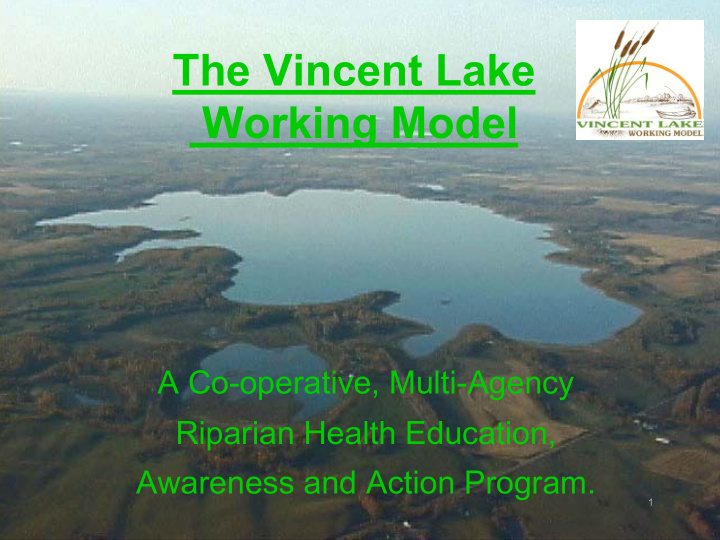



The Vincent Lake Working Model A Co-operative, Multi-Agency Riparian Health Education, Awareness and Action Program. 1
Water, A limited resource? • 97% of earth's water is salty. • 3% is fresh. • Of that 3%, 2/3 is tied up in glaciers. • Only 1% available to meet our needs. • 1/4 of remaining 1% is found in Canada. 2
The Problem • Global concern about water and water quality. • Linked to water and watersheds are riparian areas. • A very large number of riparian areas are not functioning properly, or are at risk. 3
But First, What is a Riparian Area? 4
Aspen forest Poplars Willows Cattails Water Table Upland Lake Riparian Area Location of the Riparian Area 5
Why the Problem Persists • The size of the problem is HUGE! • Lack of effective public awareness. • Lack of or frustrated enforcement. • Disconnected responses to the problem. 6
What Can We Do? • Public Lands initiative. • Communication starts. • Partnership starts to form. • The “Vision” comes out. 7
The Vision • A riparian health education, awareness and action program that results in measurable improvement in riparian knowledge of targeted individuals and groups and health of targeted sites within three years of commencement. 8
The Problem How?? The Vision The Team 9
Enter “The Process” Adopted and adapted the Cows & Fish Program “Process.” – Education and Awareness . • “Passive” Enforcement – Team Building. – Tool Building. – Community Based Action. 10
Process Implementation - TIME Education and Awareness Team Building Tool Building Community Based Action 11
Where to start using the Process? • Too many places to go! • Vincent Lake chosen. 12
Why Vincent Lake? • Representative of NEBR developed lakes. • Already had riparian work done on it. • Local lake, local staff, local knowledge. 13
N Moose Lake Highway 28A Vincent Lake Eastbourne Bangs Lake Hall Chickenhill Lake St. Paul Kehewin 4 miles Lake Miles 1 2 3 4 14
The Vincent Lake Model • Apply the process to the “Team” and “Target Audience.” • Ends November, 2002 15
Education and Awareness TEAM TARGET • Values, needs, • What is a healthy wants, perceptions, riparian area? strengths and • What are your legal limitations. responsibilities? • What can you do about it? 16
Education and Awareness • What is “Passive Enforcement?” • Delivery of “regulatory” information to the target audience. • Link to “Active” enforcement outside the process. 17
Team Building TEAM TARGET • The power of “we”. • Local individuals, groups or • Partners. associations. • Large “C” • Small “c” • Consultative. 18
Tool Building TEAM TARGET • Tools we have. • Deliver the Team tools using reiterative • Tools we are approach. building. • Tools we plan to build. 19
Some of the Tools we Use • Caring for Shoreline Properties booklet. (ACA & F&W) • Caring for the Green Zone booklet. (Cows & Fish) • Guidelines for Lakeshore Use brochure. (Ab. Env.) • Waterfront Living brochure. (Living by Water) • “The Vital Edge” video. (ACA) • Shoreline Conservation and Education Strategy (ACA). • Legislation. (F&W & DFO) 20
Some Tools we have Built • Survey of Cottage Owner Attitudes and Values report. (Equus Consulting) • Building a Lake Association - 6 Steps to Success. (ACA) • VLWM Riparian Health Community Meeting Video, March 28, 2000. (Public Lands) • VLWM - Know the Laws of Vincent Lake Community Meeting Video, January 27, 2001. (Public Lands) • Draft Environmental Reserve By-laws. (F&W) 21
Some tools we are Building • Riparian Vegetation Classification System for the Boreal region. (U of M, Public Lands. 2000 - 2002) • Aerial Videography and GIS database for watershed. (ACA. 2001- 2002) • Lentic (Lake) riparian health score sheet revised to reflect Northern conditions. (Public Lands, Cows & Fish Program. 2001- 2002) • Albert Lentic Literacy Program. (EP & FEESA. 2001) • The Vincent Lake Working Model Web Site at www.healthyshorelines.com (ACA, Vincent Lake Work Group. 2001) 22
Some Tools we Hope to Build • Riparian Health Assessment workshop(s). (Public Lands, Cows & Fish. 2002.) • Re-assessment of Cottage Owner Attitudes and Values. (Consultant. 2002.) • Final Report - The Vincent Lake Model - A Stakeholder Process for Lakeshore and Watershed Health (Vincent Lake Work Group, Nov., 2002). • There will be more! 23
Community Based Action TEAM TARGET • Local staff with local • Action on the knowledge. landscape primarily driven by local groups with “help” from the “team.” 24
Export the “Process” • Provincially - to interested teams and target audiences. • Whatever we can, as soon as we can until it’s all we can. 25
Some of the Teams Philosophy “Problems can become opportunities when the right people come together.” Robert Redford “Coming together is a beginning, staying together is progress, and working together is success.” Henry Ford 26
Thanks for listening. 27
Recommend
More recommend